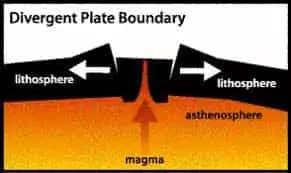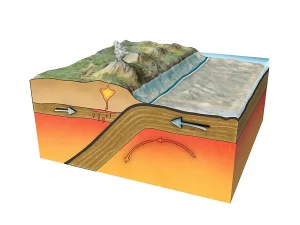Table of Contents
1. What is Plate Tectonics?
In geologic language, a plate means a large, rigid slab of solid rock. Tectonics results from the Greek whose meaning is “to build.” Keeping these two words together, we get the new word plate tectonics, which provides the meaning of how the Earth’s surface is prepared of plates.
According to the theory of plate tectonics, the Earth’s outermost layer is broken up into a number of more large and small plates that are displacing relative to one another as they run atop hotter, more mobile material.
A tectonic plate also known as a lithospheric plate is a massive, irregularly formed slab of solid rock, usually prepared of both continental and oceanic lithosphere.
Plate size can range greatly, from a hundred to thousands of kilometers across; the Pacific and Antarctic Plates are the largest plates among other plates. Plate thickness also ranges highly, varying from less than 15 km for young oceanic lithosphere to about 200 km or more earliest continental lithosphere
The lithosphere is split into tectonic plates. There are seven major depending on how they are defined and many minor plates.

The seven major plate tectonics are as follows:
a. African
b. Antarctic
c. Eurasian
d. Indo-Australian
e. North American,
f. Pacific
g. South American.
The lithospheric plates move on the asthenosphere. These plates ride in relation to one another Earthquakes, volcanic activity, mountain-building, and oceanic trench origination takes place along these plate boundaries. The lateral relative displacement of the plates commonly ranges from 0-100 mm annually.

2. Types of Plate boundary
a. Divergent (Constructive) -where new crust is generated as the plates pull away from each other.

b. Convergent (Destructive) – where the crust is destroyed as one plate dives under another.

It can be further divided into:
Continental-Continental Collision (i.e. Nepal Himalaya)
Continental-Oceanic Collision (i.e. Andes Mountain)
Oceanic- Oceanic Collision (i.e. Japan mountain)
c. Transform (Conservative) – where the crust is neither produced nor destroyed as the plates slide horizontally past each other.

| Read Also: Earthquakes are measured? |

